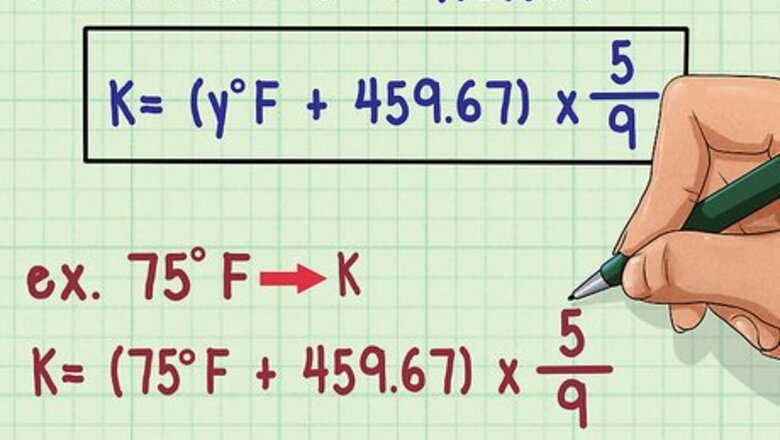
views
Converting Directly to Kelvin
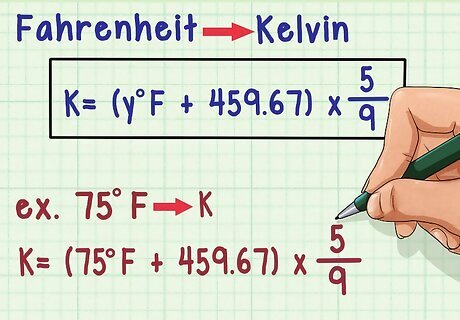
Learn the formula. There are two ways that you can convert from Fahrenheit to Kelvin, and the first is a simple calculation that makes the conversion directly. The formula to use for this is K = (y °F + 459.67) x 5/9. For example, if you needed to convert 75 °F to Kelvin, the formula would look like K = (75 °F + 459.67) x 5/9
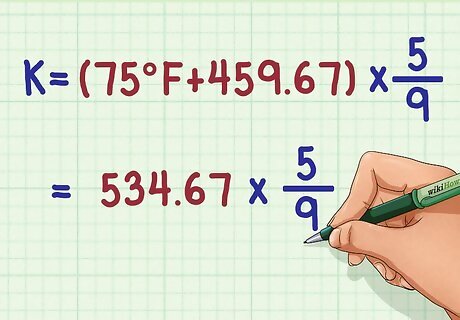
Add 459.67 to your original temperature. On the Fahrenheit scale, absolute zero is -459.67 °F, which is equivalent to 0 K. Because the Kelvin scale does not contain negative numbers, you must first add 459.67 to any Fahrenheit number when you want to make the conversion to Kelvin. In the example of converting 75 °F, the answer to the first step is 75 °F + 459.67 = 534.67
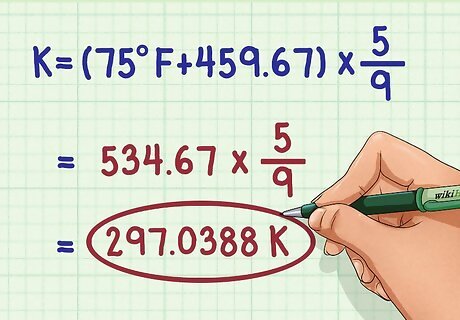
Multiply the sum by 5/9 to get the temperature in Kelvin. Remember that 5/9 can also be written as 0.55, where 5 is a repeating decimal. The answer to that product is your temperature in Kelvin. In the example of 75 °F, the answer to the second step is 5/9 x 534.67 = 297.0388, where 8 is a repeating decimal The answer to (75 °F + 459.67) x 5/9 = 297.0388 Therefore 75 °F = 297.0388 K
Converting to Celsius Then Kelvin
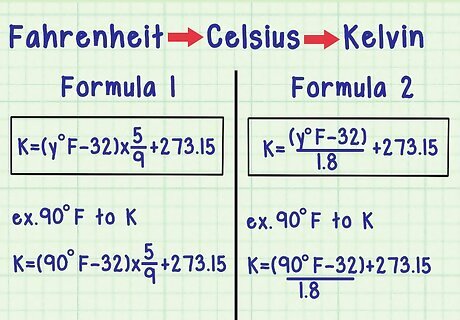
Learn the formulas. The second way of converting Fahrenheit to Kelvin involves calculating the temperature in Celsius first, which can be handy if you need to compare all the numbers. The formulas you can use to convert Fahrenheit to Celsius to Kelvin are: formula 1 is K = (y °F – 32) x 5/9 + 273.15; formula 2 is K = (y °F – 32) ÷ 1.8 + 273.15. Both formulas will produce the same result. For example, if you needed to convert 90 °F to Kelvin, the formula 1 would look like K = (90 °F – 32) x 5/9 + 273.15 The formula 2 would look like K = (90 °F – 32) ÷ 1.8 + 273.15
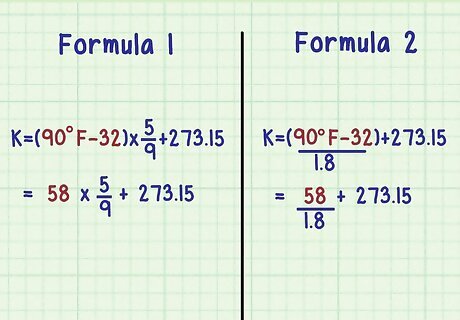
Subtract 32 from your original temperature. Regardless of the formula you use, the first step to converting Fahrenheit to Celsius to Kelvin is to subtract 32 from the original Fahrenheit temperature. In the example of 90 °F, the answer to the first step is 90 °F – 32 = 58
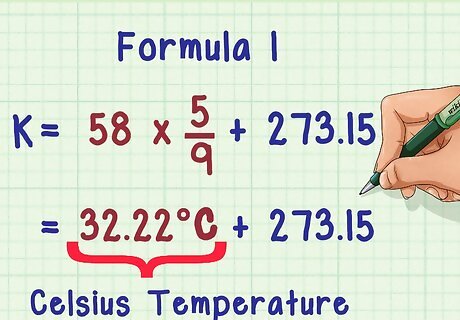
Multiply the difference by 5/9 for formula 1. Remember that 5/9 is also written as 0.55. The answer to the product is your temperature in Celsius. In the example of 90 °F, the answer to the second step for formula 1 is 58 x 0.5555 = 32.22 °C, where the 2 is a repeating decimal.
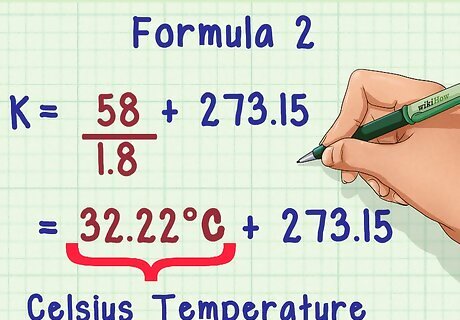
Divide the difference by 1.8 for formula 2. Dividing by 1.8 will give you the same result as multiplying by 5/9. The quotient is your temperature in Celsius. In the example of 90 °F, the answer to the second step for formula 2 is 58 ÷ 1.8 = 32.22 °C, where the 2 is a repeating decimal.
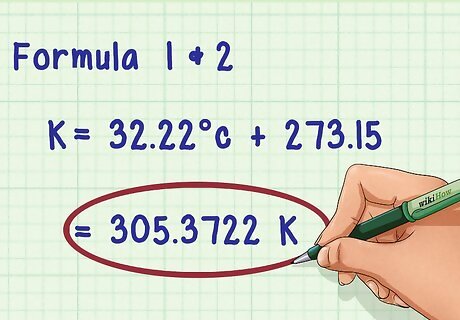
Add 273 to the product or quotient to get your temperature in Kelvin. The final step of the conversion is adding 273.15 to the product of formula 1 or the quotient of formula 2. This gives the temperature in Kelvin. Absolute zero is equivalent to -273.15 °C and 0 K, and because the Kelvin scale doesn’t have negative numbers, you must add 273.15 to the final result. In the example of 90 °F, the answer to the third step is 32.22 °C + 273.15 = 305.3722 The answer to both (90 °F – 32) x 5/9 + 273.15 and (90 °F – 32) ÷ 1.8 + 273.15 = 305.3722, where 2 is a repeating decimal. Therefore, 90 °F = 32.22 °C = 305.3722 K
Converting Kelvin to Fahrenheit
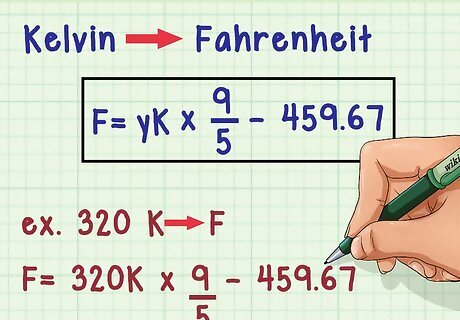
Know the formula. To convert Kelvin to Fahrenheit instead, you simply use the same formula, but in reverse. The formula for converting Kelvin to Fahrenheit is F = y K x 9/5 – 459.67. For example, to convert 320 K, you'd use the equation F = 320 K x 9/5 – 459.67

Multiply your original temperature by 9/5. Remember that 9/5 can also be written as 1.8. In the example of 320 K, the answer to step one is 320 K x 9/5 = 576.
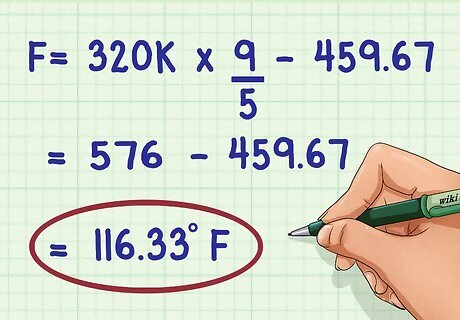
Subtract 459.67 from the product to get your temperature in Fahrenheit. Once you’ve multiplied the temperature in Kelvin by 9/5, simply subtract the Fahrenheit temperature of absolute zero (-459.67) from the product. In the example of 320 K, the answer to step two is 576 – 459.67 = 116.33 The answer to 320 K x 9/5 – 459.67 = 116.33 Therefore, 320 K = 116.33 °F

















Comments
0 comment